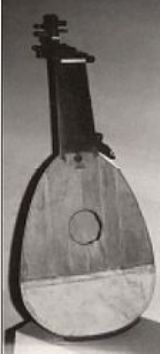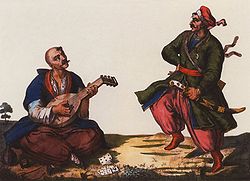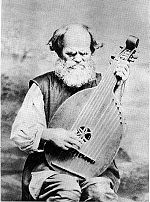
Kobza
Encyclopedia
The kobza is a Ukrainian folk music instrument of the lute
family (Hornbostel-Sachs
classification number 321.321-5+6), a relative of the Central European mandora
. The term kobza however, has also been applied to a number of other Eastern European instruments distinct from the Ukrainian kobza.
 The term kobza is of Turkic
The term kobza is of Turkic
origin and is related to the terms kobyz
and komuz
, thought to have been introduced into the Ukrainian language in the 13th century with the migration of a sizable group of Turkic people from Abkhazia
settling in the Poltava
region. It was usually played by a bard or minstrel known as a kobzar
(occasionally in earlier times a kobeznik), who accompanies his recitation of epic poetry
called duma
in Ukrainian.
The Kobza acquired widespread popularity in the 16th century, with the advent of the Hetmanate
(Cossack
state). From the 17th century the term bandura
was often used as a synonym for the kobza. The term bandura has a Latin pedigree and reflects the growing contacts the Ukrainian people had with Western Europe, particularly in the courts of Polish gentry. Ukrainian musicians that found employment at various German courts in the 18th century were called "pandoristen". One of these musicians, Timofiy Bilohradsky
, was a lute student of Sylvius Leopold Weiss
and later became a noted lute virtuoso, a court lutenist, active in Königsberg
and St.Petersburg.
In the 18th century the kobza's upper range was extended with an addition of several unstopped treble strings, known as "prystrunky
", meaning: strings on the side, in a psaltery-like set-up. In the early in the 20th century the kobza went into disuse. Currently there is a revival of authentic folk kobza playing in Ukraine, due to the efforts of the "Kobzar Guild" in Kiev
and Kharkiv
. The kobza revival however, is impeded by the absence of museum specimens: with the exceptions of a unique surviving 17th century kobza at the Muzeum Narodowe
in Kraków
and a 19th century kobza, which has been refurbished as a bandura, at the Museum of Theater and Cinematography, in Kiev; almost all evidence is entirely iconographic and some photos from the 19th century.
in the 19th and early 20th century in Ukraine
. The term was occasionally used for the bagpipes
and occasionally for the hurdy-gurdy in Eastern Poland
, Belarus
and the Volyn region in Ukraine.
The unfretted "starosvitska" bandura (a variant of gusli, developed ca. 1700 appropriated the bandura
name, but was commonly referred to as a kobza, because of the name's historical cachet while the Romanian kobza or cobza
is a different type of plucked lute.
in the 19th and early 20th century in Ukraine and was even used for bagpipes and occasionally for the hurdy-gurdy in Eastern Poland, Belarus
and the Volyn region in Ukraine. Eventually the unfretted "starosvitska" bandura (a variant of gusli, developed ca. 1800) appropriated the bandura
name, but was commonly referred to as a kobza, because of the name's historical cachet. The Romanian kobza or cobza
is a different type of plucked lute.
 There are currently two different approaches to kobza construction: authentic fretless reconstructions, produced by adherents for the recreation of authentic folk traditions, and modern stylised fretted instruments based on a modified domra
There are currently two different approaches to kobza construction: authentic fretless reconstructions, produced by adherents for the recreation of authentic folk traditions, and modern stylised fretted instruments based on a modified domra
design. To date there have been no attempts to reconstruct earlier fretted kobza of the 18th century.
Ostap Veresay (1803–1890) is today considered the foremost kobza player of the 19th century despite the fact that he referred to his instrument as a bandura
. He was a representative of the playing tradition stopping the strings along the neck but without frets. Veresay's instrument, often today referred to as traditional kobza, had six single unstopped strings mounted along the treble side of the instrument and six stoppable strings strung along the neck. The strings strung along the neck and side are plucked by the right hand with the left hand stopping the strings on the fingerboard.
 After O. Veresay's death in 1890 the instrument fell into disuse until its revival in the 1980s by Mykola Budnyk and exemplified by such players as Volodymyr Kushpet
After O. Veresay's death in 1890 the instrument fell into disuse until its revival in the 1980s by Mykola Budnyk and exemplified by such players as Volodymyr Kushpet
, Taras Kompanichenko
, Eduard Drach
, and Jurij Fedynskyj
.
, who recorded a disc of kobza music for Folkways
. Konoplenko first picked up the fretted kobza before the Revolution in 1917 in Kiev from Vasyl' Potapenko
and played on this instrument after emigrating to Winnipeg
, Canada. Konoplenko's instrument had eight strings strung along the neck and four treble strings strung on the soundboard. The tuning used was reminiscent to that of the seven-string Russian guitar tuning (open G tuning).
Fretted kobzas were also developed by Mykola Prokopenko, who wrote a PhD dissertation in 1976 on his efforts to reconstruct and resurrect the fretted Kobza. Prokopenko suggested that the four-stringed domra
, an instrument widely taught in music schools in Ukraine but considered a Russian folk instrument but actually not used in Russia, be replaced by the fretted kobza. Although Prokopenko's suggestion was not supported in 1976, it is currently being resurrected by musicians in Ukraine in the Academic folk instrument movement, particularly at the Kiev conservatory.
Lute
Lute can refer generally to any plucked string instrument with a neck and a deep round back, or more specifically to an instrument from the family of European lutes....
family (Hornbostel-Sachs
Hornbostel-Sachs
Hornbostel–Sachs is a system of musical instrument classification devised by Erich Moritz von Hornbostel and Curt Sachs, and first published in the Zeitschrift für Ethnologie in 1914. An English translation was published in the Galpin Society Journal in 1961...
classification number 321.321-5+6), a relative of the Central European mandora
Mandora
A mandora is a type of lute. The terms referred to different instruments at different periods in history.-Treble instrument:During the Renaissance, the term mandore was applied to the treble lute and in such usage it is difficult to distinguish from the mandola, the simple lute that is the ancestor...
. The term kobza however, has also been applied to a number of other Eastern European instruments distinct from the Ukrainian kobza.
Construction
The Ukrainian kobza was traditionally gut-strung, with a body hewn from a single block of wood. Instruments with a staved assembly also exist. The kobza has a medium length neck which may or may not have tied-on frets, which were usually made of gut. It was single-strung (sometimes also double-strung) and the strings were played with fingertips or occasionally with a plectrum threaded through a ring placed on the middle finger.History

Turkic languages
The Turkic languages constitute a language family of at least thirty five languages, spoken by Turkic peoples across a vast area from Eastern Europe and the Mediterranean to Siberia and Western China, and are considered to be part of the proposed Altaic language family.Turkic languages are spoken...
origin and is related to the terms kobyz
Kobyz
The Kobyz or kyl-kobyz is an ancient Kazakh string instrument. It has two strings made of horsehair. The resonating cavity is usually covered with goat leather....
and komuz
Komuz
The komuz or qomuz , Azeri Gopuz, Turkish Kopuz, is an ancient fretless string instrument used in Central Asian music, related to certain other Turkic string instruments and the lute....
, thought to have been introduced into the Ukrainian language in the 13th century with the migration of a sizable group of Turkic people from Abkhazia
Abkhazia
Abkhazia is a disputed political entity on the eastern coast of the Black Sea and the south-western flank of the Caucasus.Abkhazia considers itself an independent state, called the Republic of Abkhazia or Apsny...
settling in the Poltava
Poltava
Poltava is a city in located on the Vorskla River in central Ukraine. It is the administrative center of the Poltava Oblast , as well as the surrounding Poltava Raion of the oblast. Poltava's estimated population is 298,652 ....
region. It was usually played by a bard or minstrel known as a kobzar
Kobzar
A Kobzar was an itinerant Ukrainian bard who sang to his own accompaniment.-Tradition:Kobzars were often blind, and became predominantly so by the 1800s...
(occasionally in earlier times a kobeznik), who accompanies his recitation of epic poetry
Epic poetry
An epic is a lengthy narrative poem, ordinarily concerning a serious subject containing details of heroic deeds and events significant to a culture or nation. Oral poetry may qualify as an epic, and Albert Lord and Milman Parry have argued that classical epics were fundamentally an oral poetic form...
called duma
Duma (epic)
A Duma is a sung epic poem which originated in Ukraine during the Hetmanate Era in the sixteenth century...
in Ukrainian.
The Kobza acquired widespread popularity in the 16th century, with the advent of the Hetmanate
Hetmanate
The Ukrainian State or The Hetmanate was a short-lived polity in Ukraine, installed by Ukrainian Cossacks and military organizations under the support of the Central Powers, after disbanding the Central Rada of the Ukrainian National Republic on 28 April 1918.-History:On April 29, 1918 the head...
(Cossack
Cossack
Cossacks are a group of predominantly East Slavic people who originally were members of democratic, semi-military communities in what is today Ukraine and Southern Russia inhabiting sparsely populated areas and islands in the lower Dnieper and Don basins and who played an important role in the...
state). From the 17th century the term bandura
Bandura
Bandura refers to a Ukrainian plucked string folk instrument. It combines elements of a box zither and lute, as well as its lute-like predecessor, the kobza...
was often used as a synonym for the kobza. The term bandura has a Latin pedigree and reflects the growing contacts the Ukrainian people had with Western Europe, particularly in the courts of Polish gentry. Ukrainian musicians that found employment at various German courts in the 18th century were called "pandoristen". One of these musicians, Timofiy Bilohradsky
Timofiy Bilohradsky
Timofiy Bilohradsky was a lutenist, composer and kobzar-bandurist of Ukrainian ethnicity, active in St. Petersburg and Königsberg....
, was a lute student of Sylvius Leopold Weiss
Sylvius Leopold Weiss
Silvius Leopold Weiss was a German composer and lutenist.Born in Grottkau near Breslau, the son of Johann Jacob Weiss, also a lutenist, he served at courts in Breslau, Rome, and Dresden, where he died...
and later became a noted lute virtuoso, a court lutenist, active in Königsberg
Königsberg
Königsberg was the capital of East Prussia from the Late Middle Ages until 1945 as well as the northernmost and easternmost German city with 286,666 inhabitants . Due to the multicultural society in and around the city, there are several local names for it...
and St.Petersburg.
In the 18th century the kobza's upper range was extended with an addition of several unstopped treble strings, known as "prystrunky
Prystrunky
Prystrunky - term used for the additional strings strung across the body of Ukrainian folk instruments such as the kobza, bandura and torban. Literally meaning "Near the strings". These additional strings are thought to have appeared on these instruments in the 17th century. On the contemporary...
", meaning: strings on the side, in a psaltery-like set-up. In the early in the 20th century the kobza went into disuse. Currently there is a revival of authentic folk kobza playing in Ukraine, due to the efforts of the "Kobzar Guild" in Kiev
Kiev
Kiev or Kyiv is the capital and the largest city of Ukraine, located in the north central part of the country on the Dnieper River. The population as of the 2001 census was 2,611,300. However, higher numbers have been cited in the press....
and Kharkiv
Kharkiv
Kharkiv or Kharkov is the second-largest city in Ukraine.The city was founded in 1654 and was a major centre of Ukrainian culture in the Russian Empire. Kharkiv became the first city in Ukraine where the Ukrainian Soviet Socialist Republic was proclaimed in December 1917 and Soviet government was...
. The kobza revival however, is impeded by the absence of museum specimens: with the exceptions of a unique surviving 17th century kobza at the Muzeum Narodowe
National Museum, Kraków
The National Museum in Kraków , established in 1879, is the main branch of Poland's National Museum, which has many permanent collections around the country.-History:...
in Kraków
Kraków
Kraków also Krakow, or Cracow , is the second largest and one of the oldest cities in Poland. Situated on the Vistula River in the Lesser Poland region, the city dates back to the 7th century. Kraków has traditionally been one of the leading centres of Polish academic, cultural, and artistic life...
and a 19th century kobza, which has been refurbished as a bandura, at the Museum of Theater and Cinematography, in Kiev; almost all evidence is entirely iconographic and some photos from the 19th century.
Etymology
The term kobza first appeared in Polish chronicles dating back to 1331 CE. In popular parlance the term Kobza was applied to any regional lute-like instrument used by court musicians in Central-Eastern Europe. The term was occasionally used for other musical instruments of several unrelated types. The term kobza was also used in historical sources and folk song as a synonym of banduraBandura
Bandura refers to a Ukrainian plucked string folk instrument. It combines elements of a box zither and lute, as well as its lute-like predecessor, the kobza...
in the 19th and early 20th century in Ukraine
Ukraine
Ukraine is a country in Eastern Europe. It has an area of 603,628 km², making it the second largest contiguous country on the European continent, after Russia...
. The term was occasionally used for the bagpipes
Bagpipes
Bagpipes are a class of musical instrument, aerophones, using enclosed reeds fed from a constant reservoir of air in the form of a bag. Though the Scottish Great Highland Bagpipe and Irish uilleann pipes have the greatest international visibility, bagpipes of many different types come from...
and occasionally for the hurdy-gurdy in Eastern Poland
Poland
Poland , officially the Republic of Poland , is a country in Central Europe bordered by Germany to the west; the Czech Republic and Slovakia to the south; Ukraine, Belarus and Lithuania to the east; and the Baltic Sea and Kaliningrad Oblast, a Russian exclave, to the north...
, Belarus
Belarus
Belarus , officially the Republic of Belarus, is a landlocked country in Eastern Europe, bordered clockwise by Russia to the northeast, Ukraine to the south, Poland to the west, and Lithuania and Latvia to the northwest. Its capital is Minsk; other major cities include Brest, Grodno , Gomel ,...
and the Volyn region in Ukraine.
The unfretted "starosvitska" bandura (a variant of gusli, developed ca. 1700 appropriated the bandura
Bandura
Bandura refers to a Ukrainian plucked string folk instrument. It combines elements of a box zither and lute, as well as its lute-like predecessor, the kobza...
name, but was commonly referred to as a kobza, because of the name's historical cachet while the Romanian kobza or cobza
Cobza
The cobza is a Romanian and Moldovan folk instrument of the lute family . It is distinct from the Ukrainian kobza, an instrument of a different organology and origin....
is a different type of plucked lute.
Other instruments known as kobza
The term kobza was also used as a synonym in historical sources for banduraBandura
Bandura refers to a Ukrainian plucked string folk instrument. It combines elements of a box zither and lute, as well as its lute-like predecessor, the kobza...
in the 19th and early 20th century in Ukraine and was even used for bagpipes and occasionally for the hurdy-gurdy in Eastern Poland, Belarus
Belarus
Belarus , officially the Republic of Belarus, is a landlocked country in Eastern Europe, bordered clockwise by Russia to the northeast, Ukraine to the south, Poland to the west, and Lithuania and Latvia to the northwest. Its capital is Minsk; other major cities include Brest, Grodno , Gomel ,...
and the Volyn region in Ukraine. Eventually the unfretted "starosvitska" bandura (a variant of gusli, developed ca. 1800) appropriated the bandura
Bandura
Bandura refers to a Ukrainian plucked string folk instrument. It combines elements of a box zither and lute, as well as its lute-like predecessor, the kobza...
name, but was commonly referred to as a kobza, because of the name's historical cachet. The Romanian kobza or cobza
Cobza
The cobza is a Romanian and Moldovan folk instrument of the lute family . It is distinct from the Ukrainian kobza, an instrument of a different organology and origin....
is a different type of plucked lute.
The modern Ukrainian kobza

Domra
The domra is a long-necked Russian string instrument of the lute family with a round body and three or four metal strings.-History:In 1896, a student of Vasily Vasilievich Andreyev found a broken instrument in a stable in rural Russia...
design. To date there have been no attempts to reconstruct earlier fretted kobza of the 18th century.
The fretless kobza
The kobzarKobzar
A Kobzar was an itinerant Ukrainian bard who sang to his own accompaniment.-Tradition:Kobzars were often blind, and became predominantly so by the 1800s...
Ostap Veresay (1803–1890) is today considered the foremost kobza player of the 19th century despite the fact that he referred to his instrument as a bandura
Bandura
Bandura refers to a Ukrainian plucked string folk instrument. It combines elements of a box zither and lute, as well as its lute-like predecessor, the kobza...
. He was a representative of the playing tradition stopping the strings along the neck but without frets. Veresay's instrument, often today referred to as traditional kobza, had six single unstopped strings mounted along the treble side of the instrument and six stoppable strings strung along the neck. The strings strung along the neck and side are plucked by the right hand with the left hand stopping the strings on the fingerboard.

Volodymyr Kushpet
Volodymyr Kushpet is an influentian Ukrainian baritone singer, and player on torban, kobza, bandura and lira, noted reconstruction of traditional playing techniques on these instruments....
, Taras Kompanichenko
Taras Kompanichenko
Таras Коmpanichenkо is an influential kobzar, bandurist, lira player, composer and singer-songwriter. He is an active member in the Kiev Kobzar Guild as well as in the Early Music ensembles "Chorea Kozacka" and "Sarmatica"...
, Eduard Drach
Eduard Drach
Eduard Drach born 1965 in Kryvyi Rih, in Dnipropetrovsk Oblast, in the Ukrainian SSR of the Soviet Union – in present-day Ukraine) is а prominent and influential composer, singer-songwriter, kobzar and bandurist. He is an active member in the Kiev Kobzar Guild...
, and Jurij Fedynskyj
Jurij Fedynskyj
Jurij Fedynskyj is a Ukrainian-American folk singer, kobzar and bandurist as well as a composer, producer, luthier, sound engineer, cultural activist and educator....
.
The modern fretted kobza
A fretted version of the kobza was used by Paul Konoplenko-ZaporozhetzPaul Konoplenko-Zaporozhetz
Konoplenko-Zaprozhetz, Paul - Canadian Kobza player.Konoplenko origninally procured his kobza from bandurist Vasyl' Potapenko in Kyiv before the revolution in 1902...
, who recorded a disc of kobza music for Folkways
Folkways
Folkways can refer to:*Folkways —theory by the sociologist William Graham Sumner.*Folkways Records—a record label founded by Moe Asch....
. Konoplenko first picked up the fretted kobza before the Revolution in 1917 in Kiev from Vasyl' Potapenko
Vasyl' Potapenko
Vasyl' Potapenko born in Berezna, Mensk region, Chernihiv province was the guide-boy for the blind kobzar Tereshko Parkhomenko. As a guide-boy he was a participant of the ХІІth Archeological congress held in Kharkiv in 1902. He travelled to Halychyna by himself after discovering that Hnat...
and played on this instrument after emigrating to Winnipeg
Winnipeg
Winnipeg is the capital and largest city of Manitoba, Canada, and is the primary municipality of the Winnipeg Capital Region, with more than half of Manitoba's population. It is located near the longitudinal centre of North America, at the confluence of the Red and Assiniboine Rivers .The name...
, Canada. Konoplenko's instrument had eight strings strung along the neck and four treble strings strung on the soundboard. The tuning used was reminiscent to that of the seven-string Russian guitar tuning (open G tuning).
Fretted kobzas were also developed by Mykola Prokopenko, who wrote a PhD dissertation in 1976 on his efforts to reconstruct and resurrect the fretted Kobza. Prokopenko suggested that the four-stringed domra
Domra
The domra is a long-necked Russian string instrument of the lute family with a round body and three or four metal strings.-History:In 1896, a student of Vasily Vasilievich Andreyev found a broken instrument in a stable in rural Russia...
, an instrument widely taught in music schools in Ukraine but considered a Russian folk instrument but actually not used in Russia, be replaced by the fretted kobza. Although Prokopenko's suggestion was not supported in 1976, it is currently being resurrected by musicians in Ukraine in the Academic folk instrument movement, particularly at the Kiev conservatory.
- Orchestral kobza, with four strings tuned in fifths using tunings that parallel those used by the instruments of the violin family. The instruments are made in prima (soprano), alto and tenor and contrabass sizes.
- Accompaniment kobza, usually having six or seven strings and a fretted neckFingerboardThe fingerboard is a part of most stringed instruments. It is a thin, long strip of material, usually wood, that is laminated to the front of the neck of an instrument and above which the strings run...
. The six-string version uses standard guitar tuning. The seven-string version uses a Russian guitar (open G chord) tuning.
See also
- TheorboTheorboA theorbo is a plucked string instrument. As a name, theorbo signifies a number of long-necked lutes with second pegboxes, such as the liuto attiorbato, the French théorbe des pièces, the English theorbo, the archlute, the German baroque lute, the angélique or angelica. The etymology of the name...
- BanduraBanduraBandura refers to a Ukrainian plucked string folk instrument. It combines elements of a box zither and lute, as well as its lute-like predecessor, the kobza...
- CobzaCobzaThe cobza is a Romanian and Moldovan folk instrument of the lute family . It is distinct from the Ukrainian kobza, an instrument of a different organology and origin....
- KobyzKobyzThe Kobyz or kyl-kobyz is an ancient Kazakh string instrument. It has two strings made of horsehair. The resonating cavity is usually covered with goat leather....
, a KazakhCulture of KazakhstanBefore the Russian conquest, the Kazaks had a well-articulated culture based on their nomadic pastoral economy. Islam was introduced to Kazakhstan in the 7th to 12th century. Besides lamb, many other traditional foods retain symbolic value in Kazak culture...
bowed string instrument - Ukrainian folk musicUkrainian folk musicUkrainian folk music includes a number of varieties of ethnic , folkloric, folk inspired popular and folk inspired classical traditions....

